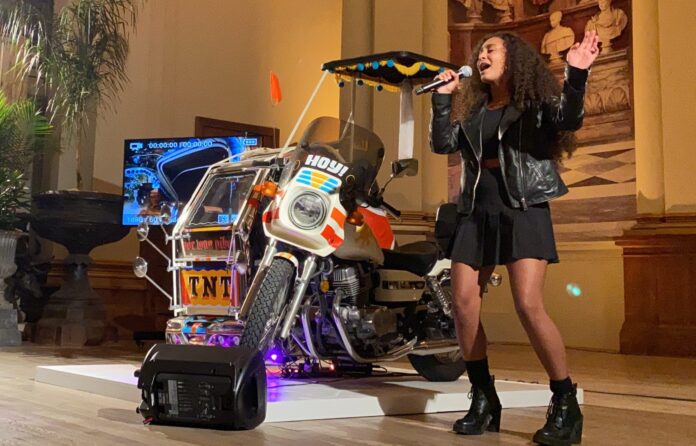Paolo Asuncion and Michael Arcega met at an art event about eight years ago. They started talking because Asuncion, a motorcycle rider, always introduces himself to people carrying helmets, which Arcega was. When they found out they were both Filipino (as well as motorcycle lovers), they started getting into family history. When Arcega told Asuncion his name, Asuncion told him that his brother’s best friend as a kid in the Philippines was also named Arcega.
It turned out that kid was Arcega’s brother. The two became friends themselves, and when Arcega, a sculptor who teaches art at San Francisco State University, heard that the SOMA Pilipinas cultural district wanted some Filipino art installations and the San Francisco Arts Commission was offering grants and support, he asked Asuncion, a filmmaker who’s made films about motorcycles, if he was interested in collaborating on something.
“I said, ‘Hell yeah,’” Asuncion said. For their project, they decided on a kind of transportation common in the Philippines, a custom-built motorcycle with an attached sidecar, called a tricycle (“traysikel” in the Philippines.) They called their mobile sculpture a TNT Traysikel, and installed a karaoke machine in it, as a form of community interactivity.
“We wanted to create this object as a visual punctuation. It’s very loud and very present,” Arcega said. “Initially, we were going to build it from scratch, but one came up for sale in Modesto, and we decided to buy that and trick it out.”
Now the TNT Traysikel is on display in the Asian Art Museum, part of the show Carlos Villa: Worlds in Collision. On Thu/11, the museum is hosting “An Evening of Karaoke and Community Sing-Along” that activates it in full karaoke mode.
“We started with fabrication and strengthening parts of it,” Asuncion said about building the tricycle. “In the Philippines, it’s attached to a much smaller motorcycle. And you use whatever resources you can. In some, you could see the logos for the cookie tins they used.”
Artist Michelle Nguyen decorated it with “symbols and markers of Filipino-ness” although Asuncion says he did several brushstrokes, and he reminds his friends that Arcega painted the license plate.
Tricycles aren’t the only customized and repurposed form of transportation in the Philippines. After World War II, American troops left military jeeps in the country, which were stripped and altered and became Jeepneys, a type of public transportation that carry around a dozen people.
The tricycles are smaller, and inspire a lot of memories, Arcega says. When people sit in it, they often start reminiscing about their time in the Philippine. So, Arcega and Asuncion thought about making it into a kind of story booth. But then they took it out for a drive around the holidays in 2019, playing Christmas songs though their phones, people started singing along. They decided karaoke seemed like a good idea.
“Musicians are one of the Philippines’ biggest exports,” Asuncion said. “Any cruise ship that has a band, it’s a Filipino band and you always see Filipino bands in Japan and Dubai and England.”
Arcega added that the singer who replaced Steve Perry in the band Journey, Arnel Pineda, is Filipino. “They searched all over the world, and he was singing and posting on YouTube, and they found him and recruited him,” Arcega said. “In a way, Journey is his karaoke band. He sounds just like Steve Perry.”
The response when they take the Traysikel out for a spin is beyond enthusiastic, Arcega says. “People will stop us, they will drive like maniacs to get near us, they’ll sometimes jump out of the car to take a picture with us,” he said. “The surprise of seeing a Filipino tricycle is shocking and brings up excitement.”
One day, Asuncion saw that the NorCal Pinoy Riders motorcycle club planned to ride across the Golden Gate Bridge. He and Arcega decided to go as well, thinking it would be fun to join in. But the attention the TNT Traysikel got surprised them, including being covered on the national news in the Philippines.
Asuncion says a lot of the coverage had a triumphant tone to it. Arcega thinks that could be because rather than taking an American symbol and turning it into something in the Philippines (like with the jeepney), they’d taken a symbol of the Philippines, the tricycle, and brought it to America.
“We flipped it in a way,” he said. “It was this Filipino thing, this humble tricycle, and it was crossing this American monument.”
Sitting in the TNT Traysikel and singing is a celebratory experience, Asuncion says. And God knows, we could all use some of that. “People get really happy and joyful,” he said. “Over the pandemic, especially with all the anti-Asian sentiment, it’s felt like a release of tension as a community.”
Arcega adds that sometimes people think that they shouldn’t be too loud, and there’s the stereotype of Asians as a “model minority” that stay quiet.
“The boldness of this project is kind of the opposite of that,” he said. “It’s a loud thing and visually it’s loud too. Sometimes I get looks like it doesn’t belong in the streets, like from this guy in a BMW. Like, bro, why are you staring at me? Yeah, we’re here and what of it? We’ve been here for over 100 years.”
AN EVENING OF KARAOKE AND COMMUNITY SING-ALONG happens Thu/11, 5pm, at the Asian Art Museum, SF. More information here





